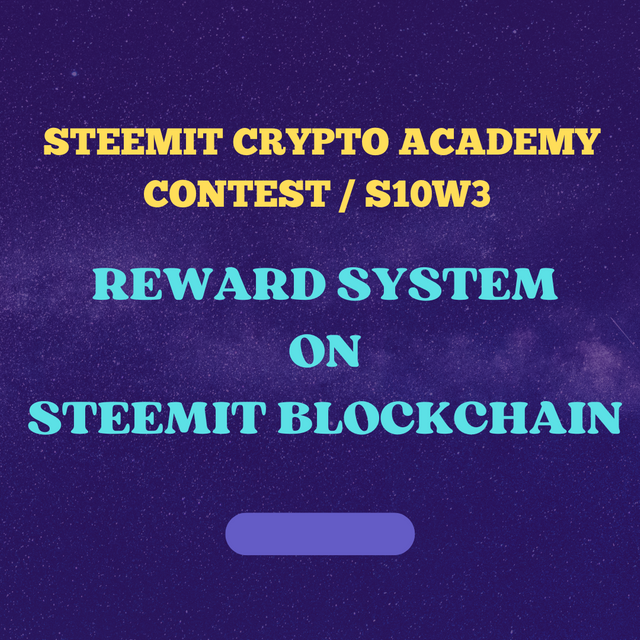Hello friends, how are you, I hope you are well and healthy, this is my second post in this community, I did not get any response to my first post, but I hope that inshallah I will get a good response.

Does the attribution of rewards on steemit follow the same convergent linear reward curve since its creation or has it undergone some modifications? If yes, talk about the causes of this change?
Steemit, a decentralized social media platform built on the Steem blockchain, initially employed a reward system that followed a coincident direct curve. This meant that the rewards earned by users were directly commensurable to the popularity of their content, measured by the number of upvotes received. The formula used to calculate rewards followed a quadratic function f( x) = x2, where x represented the number of upvotes.
However, since its creation, Steemit has undergone some modifications to address certain concerns and improve the platform's sustainability. One significant change involved the implementation of a new reward curve formula. The current reward curve on Steemit follows a modified direct function f( x) = x2/( x 1).
This modification was introduced to address implicit issues arising from the earlier reward curve. The original quadratic curve rewarded content disproportionately, which led to the concentration of rewards among a many popular druggies, creating an imbalance in the distribution of incentives. The updated curve aims to make the reward distribution more indifferent by gradationally flattening the reward growth as the number of upvotes increases.
By using the modified direct curve, Steemit encourages a broader participation and engagement within the platform, as users can receive further commensurable rewards. This adjustment fosters a more inclusive ecosystem where content creators with varying levels of popularity have a better chance to earn prices commensurate with their contributions.
It's important to note that the specific details and parameters of the reward curve on Steemit, including any unborn modifications, may be subject to changes determined by the Steem blockchain's governance and the platform's development team.
The modifications to Steemit's reward attribution system were driven by several factors and challenges faced by the platform. These causes can be attributed to colorful issues that emerged as the platform evolved and grew in popularity. Here are some of the crucial causes of the changes
Quality and spam concerns As Steemit gained traction, there was a growing concern about the quality of content and the prevalence of spam. The original reward distribution system grounded solely on popularity and influence led to the implicit manipulation of rewards through artificial voting and low- value content. To address these concerns and encourage advanced- quality contributions, Steemit sought to modify the reward system to consider factors similar as happy quality, engagement, and reputation.
Inequitable reward distribution The original reward curve faced criticism for its perceived imbalances in price distribution. Some users with significant voting power were suitable to disproportionately benefit from the system, leading to a concentration of rewards among a many influential individuals or groups. This created a need for a more fair and indifferent distribution model that rewarded genuine engagement and participation from a wider user base.
Sustainability and long- term viability Steemit recognized the importance of creating a sustainable platform that would continue to attract and retain users. The original reward system faced challenges in maintaining a steady flow of rewards and ensuring the long- term viability of the platform. The modifications aimed to introduce further predictability and stability in the reward distribution, allowing for a sustainable growth trajectory.
Community engagement and curation Steemit acknowledged the pivotal role played by the community in curating and promoting precious content. The introduction of curation rewards aimed to incentivize active participation from users in discovering and upvoting high- quality posts. By involving the community in the reward process, Steemit aimed to foster a sense of ownership and engagement while ensuring that precious content received recognition and rewards.
Platform evolution and user feedback Steemit's modifications to the reward system were also influenced by user feedback and the evolution of the platform itself. As Steemit grew, user input and suggestions played a significant role in shaping the reward attribution system. The platform sought to incorporate user perspectives and address their concerns to create a further inclusive and user- centric reward model.
The changes to Steemit's reward attribution system were primarily driven by the need to address quality and spam concerns, create a further indifferent reward distribution, ensure sustainability, foster community engagement, and incorporate user feedback. These modifications aimed to enhance the overall user experience and create a platform that rewards genuine contributions and participation.
Show the added value that brought it this convergent linear reward curve, and how this system is applied on Steemit Blockchain.
The coincident direct reward curve implemented on the Steemit Blockchain brought several added values to the platform. This reward system aimed to incentivize and reward both content creators and curators based on the perceived value and quality of their contributions. Here is how this system was applied and its benefits
Encouragement of quality content
The coincident direct reward curve rewarded content creators who produced high- quality, precious content that resonated with the community. By considering factors similar as engagement, reputation, and happy quality, the system incentivized users to focus on creating instructional, amusing, or perceptive content, leading to an overall improvement in the quality of posts on Steemit.
Reduction of voting manipulation
The direct reward curve helped mitigate the impact of voting manipulation on the platform. Unlike a purely popular system where votes are weighed equally, the curve factored in the voting power of users, discouraging artificial voting schemes and encouraging organic voting patterns. This reduced the potential for rewards to be concentrated in the hands of a many influential individuals or groups.
Fair reward distribution
The coincident direct reward curve aimed to create a fairer reward distribution model. It ensured that druggies with varying levels of influence and voting power could contribute to the reward pool. By considering the overall popularity and perceived value of a post, the system provided opportunities for users with different situations of influence to earn prices proportionate to their contribution.
Sustainable growth
The reward curve also played a role in the long- term sustainability of the platform. It provided a balance between satisfying popular content that attracted a wider audience and recognizing niche or technical content that catered to specific communities. This balance helped maintain a different range of content on the platform, attracting and retaining users with different interests and ensuring the platform's continued growth.
The coincident direct reward curve applied on the Steemit Blockchain added value by encouraging quality content creation, reducing voting manipulation, ensuring fair reward distribution, and contributing to the sustainable growth of the platform. By considering multiple factors in the reward attribution process, Steemit aimed to create a platform where genuine engagement and precious contributions were recognized and rewarded.
What is the difference between isolated curation and community curation? What type of curation do you prefer for quality content in Steem Blockchain?
Isolated curation and community curation are two approaches to curating content on platforms like Steemit.
Isolated curation refers to individual users independently curating and evaluating content grounded on their own criteria and preferences. Each user curates content without direct interaction or coordination with others, making their curation decisions in isolation.
On the other hand, community curation involves collaborative evaluation and decision- making by a group of users. These users come together to curate content, often through discussions, voting, or consensus- building mechanisms. Community curation aims to leverage the wisdom of the crowd and foster cooperative decision- making to identify and promote precious content.
Both approaches have their merits and drawbacks, with isolated curation allowing for individual autonomy but potentially leading to fractured curation efforts, while community curation encourages collaborative involvement but may involve compromises and slower decision- making processes.
Steem Blockchain is a decentralized social media platform that places a strong emphasis on curation and high- quality content. With its unique reward system, users have the power to curate the stylish content by upvoting and distributing tokens. This incentivizes creators to produce exceptional content, ensuring a curated feed of the loftiest quality. Steem Blockchain encourages engagement and interaction among its community members, fostering a vibrant ecosystem that values originality and expertise. By prioritizing curation, Steem Blockchain promotes the discovery of top- notch content, creating a platform where users can find and appreciate the very best that the community has to offer.
Does the community curation have only a financial contribution or other benefits, if so which ones?
Community curation in the Steem Blockchain offers benefits beyond just fiscal contributions. While the fiscal aspect is a significant incentive, the platform aims to create a well- rounded and satisfying experience for users. Here are some fresh benefits of community curation in Steem
Influence and Recognition
Through curation, users have the opportunity to shape the platform's content and contribute to its overall quality. By curating high- quality posts, users gain influence within the community and can become recognized as trusted curators.
Engagement and Networking
Curation encourages users to actively engage with content creators and fellow curators. By participating in discussions, leaving comments, and providing feedback, curators can foster connections, build relationships, and expand their network within the community.
Discovering Hidden Gems
Curation allows users to uncover retired or lower- known content creators who may have exceptional talent but limited visibility. By promoting similar creators, curators help to bring meritorious content to the forefront and increase its exposure.
Personal Growth and Learning
Engaging in curation requires a critical eye and the ability to identify quality content. By continuously evaluating and curating posts, users can develop their own skills, learn from others, and gain insights into different topics and perspectives.
Community Building
Curation contributes to the overall growth and development of the Steem community. By actively curating and promoting quality content, users help to foster a positive and probative environment, attracting further creators and curators to join the platform.
In summary, while fiscal contributions are an important aspect of community curation in Steem, users also benefit from influence, recognition, engagement, networking opportunities, the discovery of retired talents, particular growth, and contributing to a thriving community.
Conclusion
Community curation in the Steem Blockchain offers not only fiscal contributions but also benefits similar as influence, recognition, engagement, networking, discovering retired gems, particular growth, and community building. It creates a well- rounded and satisfying experience for users, fostering a vibrant and high- quality content ecosystem. Invite to @rosselena @f2i5 @anelafatima

Saludos.
Un tema bastante interesante y es bueno conocer cómo era en sus inicios Steemit. Las recompensas y como hacernos bien para que nos beneficie y a su vez apoye a la comunidad.
Muy bien explicado y en detalles con cada intervención. Gracias por compartir y participar.
Mis mejores deseos para ti.
Downvoting a post can decrease pending rewards and make it less visible. Common reasons:
Submit
Es un buen post ordenado en ideas y con detalles. De acuerdo con tu percepción que la curva lineal convergente ha contribuido en la creación de contenidos de calidad en el ecosistema aparte de la interacción.
Saludos cordiales y mucha suerte con el desafío.
Downvoting a post can decrease pending rewards and make it less visible. Common reasons:
Submit
Brother @azamjee
Your post is very well written. I'm very glad to see that you have nicely explained the reward system of Steemit platform and also wrote well about the community curation and isolated Curation. You have also explained the financial contribution of community curation.
I wish you success in this challenge 💕
Downvoting a post can decrease pending rewards and make it less visible. Common reasons:
Submit
Thank you
Downvoting a post can decrease pending rewards and make it less visible. Common reasons:
Submit